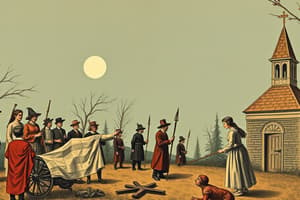Podcast
Questions and Answers
Explain the significance of Anne Hutchinson's banishment from Massachusetts Bay Colony in 1638 and its connection to the First Great Awakening.
Explain the significance of Anne Hutchinson's banishment from Massachusetts Bay Colony in 1638 and its connection to the First Great Awakening.
Anne Hutchinson's banishment from Massachusetts Bay Colony in 1638 was significant because it highlighted the growing tensions between religious leaders and dissenters. Her ideas, which challenged the authority of Puritan leaders and emphasized the importance of personal experience and individual interpretation of scripture, were later resurrected during the First Great Awakening. This movement was a reaction to Enlightenment ideas and emphasized the need for a personal, emotional connection with God.
What were the key differences between the "New Lights" and the "Old Lights" during the First Great Awakening?
What were the key differences between the "New Lights" and the "Old Lights" during the First Great Awakening?
The "New Lights" during the First Great Awakening leaned towards Antinomianism, which emphasized the importance of faith and downplayed the role of good works in salvation. The "Old Lights," on the other hand, leaned towards Arminianism, which emphasized the importance of good works and free will in salvation. These differences split New England into rival factions and contributed to the religious tensions of the time.
What was the Half-Way Covenant and why was it introduced?
What was the Half-Way Covenant and why was it introduced?
The Half-Way Covenant was introduced in response to a decline in church membership and the growing disinterest in religious idealism among second-generation settlers. It provided a limited form of church membership for those who had not experienced a full conversion but were willing to support the church and its activities. The Half-Way Covenant was proposed by Solomon Stoddard, the maternal grandfather of Jonathan Edwards, and was controversial among Puritan leaders.
Study Notes
- Anne Hutchinson was banished from Massachusetts Bay Colony in 1638.
- Hutchinson's ideas were later resurrected during the First Great Awakening.
- The First Great Awakening was a reaction to Enlightenment ideas.
- The revivalists embraced the Enlightenment's emphasis on first-hand experience.
- The First Great Awakening split New England into rival factions.
- The "New Lights" leaned towards Antinomianism while the "Old Lights" leaned towards Arminianism.
- The Half-Way Covenant was introduced in response to a decline in church membership.
- Second-generation settlers were becoming less interested in religious idealism.
- The Half-Way Covenant provided a limited form of church membership.
- The Half-Way Covenant was proposed by Solomon Stoddard, the maternal grandfather of Jonathan Edwards.
Studying That Suits You
Use AI to generate personalized quizzes and flashcards to suit your learning preferences.
Description
Test your knowledge on the religious and cultural movements that shaped colonial New England with this quiz on Anne Hutchinson, the First Great Awakening, and the Half-Way Covenant. Discover the impact of Enlightenment ideas, the split between the "New Lights" and "Old Lights," and the decline in church membership that led to the introduction of the Half-Way Covenant. See how much you know about the historical figures and events that helped shape America's religious landscape.




